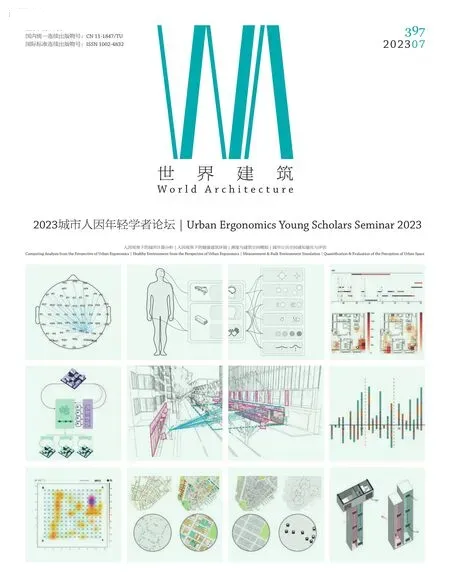马伊冬季马戏场:一个融合艺术、娱乐与技术的野性混凝土马戏场
2023-07-30卡雷尔德克斯
卡雷尔·德克斯
马戏场空间与未来前景
在最近的建筑文献中,对马戏场空间设计的研究仅出现在极少数出版物中。其中,《马戏团是一种表演,但它也是一座建筑——欧洲马戏场建筑的记忆》[1]一文为了解根特市的马伊冬季马戏场这一有意义的更新项目提供了全面的洞察力和框架,作者在下面的文章中清楚而巧妙地说明了这一点。
回顾欧洲马戏团从18 世纪到今天21 世纪的历史,可以看出马戏、其建筑概念和内容是如何随着社会事件和文化框架的变化而不断变化的。
马伊冬季马戏场代表了这些固定建筑的未来前景的一个完美的研究案例——这些建筑主要在19 世纪和20 世纪在欧洲加速发展,而在最近已经被废弃。冬季马戏场保持并扩大了其作为表演空间的使命,并且——引用作者的话——尊重材料的手工制作和诚实展示,根据《建筑的第二盏灯》[2],冬季马戏场的再生项目可以被认为是当代马戏场空间设计重新定义的基准,而该基准与当今的社会和城市需求有关。
2005 年,根特市收购了该建筑,打算在保留其重要历史价值的同时对其进行改造和再利用。其核心目标是将冬季马戏场改造成一个真正的科研场所——关注创新和健康设备,也关注艺术和创造力。其结果是一座可举办各种活动的建筑,如展览、表演、公共活动和小型博览会,从而结合城市的愿景,将马戏场空间再生为一个知识、文化和创新创业的中心。赋予该项目更多诱人意义的最后一个因素是中央竞技场下的中和CO2供暖系统,它将响应根特在2050 年实现碳中和的目标。(乔治亚·塞斯特罗 文)
简史
始建于1894年的马伊冬季马戏场隐身于街道,相当不显眼,从外面几乎识别不出。然而,一旦进入,它就会给人一种惊奇的感觉,并显示出与罗马万神殿相似的尺度和体验。巨大的圆形且类似竞技场的内部被一个混凝土大坡道所包围,顶部的玻璃天窗将观众的目光引向天空。奇怪的是,光秃秃的混凝土墙故意没有使用现代的装饰材料,却保留了其原有的魅力。路人在时间和空间上愉快地迷失了方向,因为圆形的建筑与光滑的天顶光线与建筑外的城市日常喧嚣形成了强烈的对比。
19 世纪末,许多欧洲城市出现了用于大众消遣和娱乐的特定建筑,包括石头马戏场i),如位于比利时北部根特的马伊马戏场。为了不受天气的影响,它被覆盖起来,成为一个室内的活动大厅。其他法兰德斯城市,如根特、安特卫普、布鲁塞尔也加入了这一国际性的潮流。1894 年,“新马戏场”根据建筑师埃米尔·德·维尔特的设计建造起来,作为“马戏团周边 ”(Circuswijk)的一部分。这座圆形建筑最初被设想为一个附带有联谊室的赛马场,但最终开幕时呈现为一个有顶的石头马戏场——许多公司在这里进行表演,甚至在冬天也是如此。1920 年的一场大火部分摧毁了这座脆弱的木构建筑,只剩下一些局部,如一些外墙、马厩和马术学校。于是,这些部分在1923 年由建筑师儒勒-帕斯卡尔-勒杜设计的新马戏场的建造过程中被复原。这个“新马戏场”于1944 年关门。
Circus spaces and future perspectives
In recent architectonical literature the space given to the study of the circus space design has been limited to few publications.Among thatCircus is a performance but it is also a building -memory of circus buildings in Europe[1] gives a comprehensive insight and framework within which to read the meaningful regeneration project of the Winter Circus of Mahy in Ghent,clearly and masterfully illustrated by the author in the following essay.
Going through the history of circus in Europe which occurred in between the Eighteenth century and today's twenty-first century it is clear how circus spectacle,its architectural concept and its content,has changed throughout the times,following social events and cultural frameworks of time periods.
WinterCircus Mahy represents a perfect study case of the future perspective of these stationary architectures which speeded out mainly in the Nineteen and Twenty century in Europe and which fell in disuse in the most contemporary times.Maintaining,but also enlarging,its vocation to be a space for performances and-to cite the author-respecting the handcrafted and honest display of materials,according tothe Second Lamp of Architecture[2],the regeneration project of the Winter Circus could be considered a benchmark of the contemporary redefinition of the circus space design related to the need of the nowadays social and urban needs.
In 2005,the city of Ghent acquired the building with the intention of renovating and repurposing it while preserving its significant historical value.The primary goal was to convert the Winter Circus into a dedicated hub for research and technology,emphasizing innovation and advancements in healthcare,as well as fostering art and creativity.The result will be a building hosting a wide range of activities such as exhibitions,performances,public events and small fairs so to combine the vision of the city in regenerating the circus space into a center of knowledge,culture,and innovative entrepreneurship.The last ingredient which gives to the project even a more alluring meaning is the CO2-neutral heating system hosted under the central arena which will response to the aim of Ghent to be climate-neutral by 2050.(Text by Giorgia Cestaro)

1 剖面Section
Short History
Quite hidden from the streetside,the Winter Circus of Mahy -dating from 1894-presents itself as quite anonymous and hardly discernible from the outside.However upon entering,it provides a sense of wonder and reveals a dimension and experience similar to Rome's Pantheon. A large circular and arenalike interior,encircled by a large concrete ramp and crowned by a glazed skylight,pushes the gaze of the viewer upward to the sky.Oddly enough,the bare concrete walls,deliberately untouched by modern finishing materials,have retained their original charm.The passerby is pleasantly disoriented in time and space as the circular building with smooth zenithal light contrasts heavily with the daily bustle of city just outside from the building.
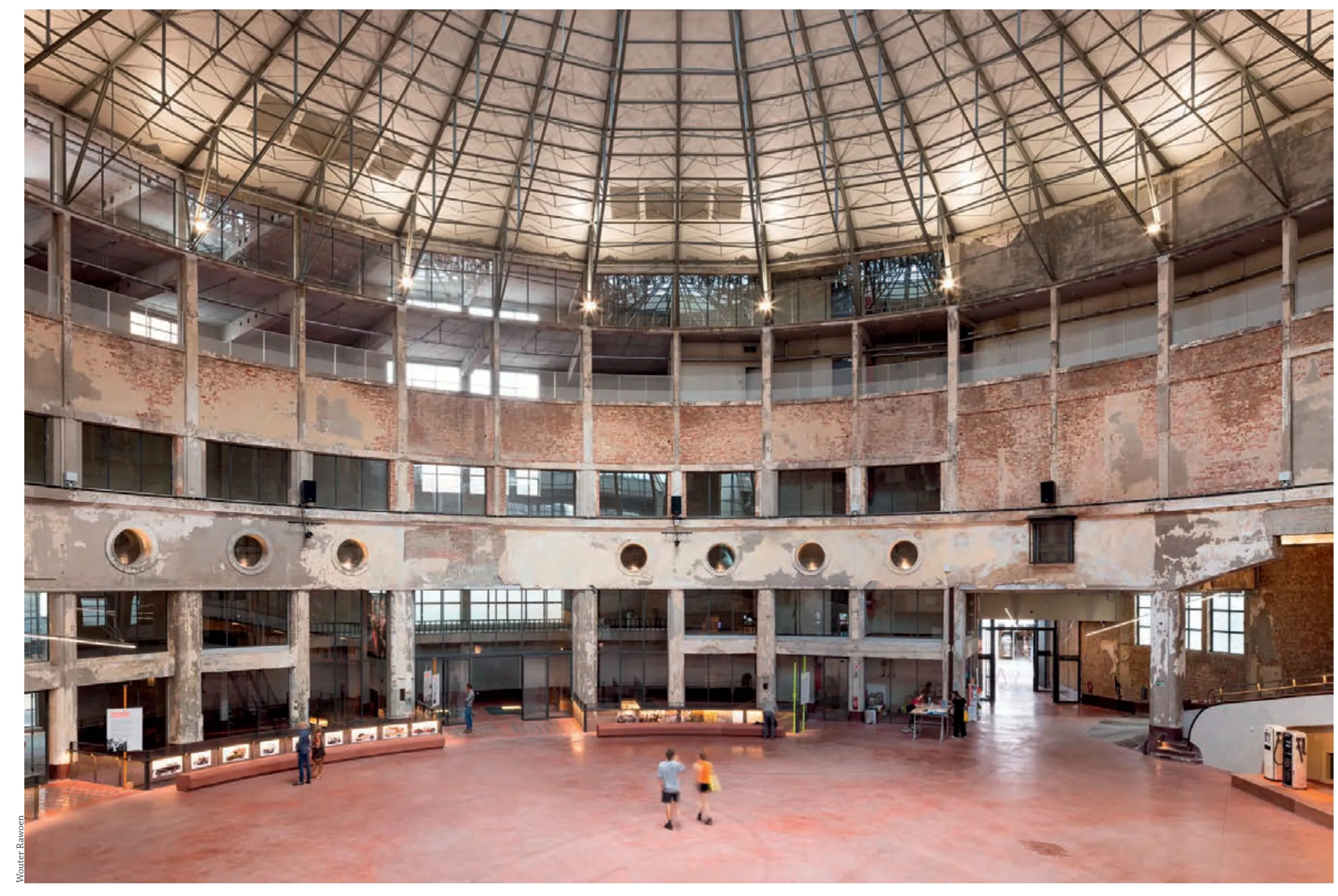
2 大厅Hall
二战结束后不久,冬季马戏场被改造成吉斯兰·马伊的车库,用于修理和销售汽车。在这次改造中,原来马戏场的木构内部被拆除,建筑被改造成一个贸易场所,但经马伊之手增加了一系列迷人的室内干预措施。他拆除了假天花板,暴露了建筑的粗犷魅力;一个新的混凝土结构与加建的斜坡系统到位,使得汽车可以一直开到顶层。随着车库在1978 年关门,该建筑继续作为老式汽车的仓库又持续了20 年。除了950 辆老爷车外,该建筑多年来一直空置,没有被使用。
但马伊的遗产——尽管他不是一个经过训练的建筑师——是令人佩服的,他的现代主义风格的加建创造了一种超现实的体验,有着丰富的景观和光线变化,以及随心所欲的室内,它们仍然与建筑的原始调性一致。
设计作为主动沉默的一种形式
2005 年,根特市购买了该建筑,目的是在尊重其丰富遗产价值的前提下进行翻新和重新利用,其核心目标是将冬季马戏场改造成一个真正的科研场所——关注创新和健康设备,也关注艺术和创造力。
2011 年,鹿特丹建筑师和规划师Kempe Thill 工作室与根特的aNNo 建筑事务所合作,赢得了冬季马戏场的改造和再利用的概念设计竞赛。2015 年,一个新的团队——BARO-SUM 接管了实际的适应性设计并完成了该项目,改变了流线以及该建筑与城市结构的关系。整体方案保留了原有的气氛和特色,尊重了建筑的历史特征。为了更好地呼应马伊飘忽不定的风格,建筑师们在建筑设计过程中自我设定了4 个重要的准则:
首先,中央竞技场——一个1200m2的有顶内院——被刻意留空,白天所有人都可以进入。对于设计师来说,竞技场的开放性是一个需要保护的品质。
其次,地下摇滚音乐厅的声学挑战需要采取具体措施,防止声音泄漏到邻近的建筑物。因为同样的原因,现有穹顶的翻新也被证明是一个挑战。屋顶的覆盖物被更新,包括有关稳定性、绝缘和声学的新限制。
第三,与罗斯金关于建筑真实的“第二盏建筑之灯”相类似的,设计师选择保留其粗糙的未涂抹的砖墙完成面,仿佛那属于建筑的灵魂。旧的石膏天花板被刷掉了,但进一步刻意保留了原样,保持了室内气氛的完整。原有的元素,如铸铁柱子和老马厩的旧石制饮水井都被保留下来。这种对过去事物的真实而明智的展示,呼应了设计师的尊重态度。
At the turn of the 19th century,specific buildings for mass recreation and delight appeared in many European cities,including stone circuses such as the Circus Mahy,located in the North of Belgium,in Ghent.In order to be immune from weather events,it was covered and became an indoor event hall.Flemish cities such as such as Ghent,Antwerp,Brussels also joined this international trend.In 1894,the so-called "New Circus" was built,after a design by architect Emile De Weerdt,as part of the "Circuswijk".The circular building,initially conceived as a horse racing track with accompanying party room,was eventually inaugurated as a covered circus,where numerous companies gave performances,even during the winter.As a fire partly destroyed the fragile wooden building in 1920,only a few parts,such as some outer walls,the stables and the riding school remained.These parts were therefore recovered during the construction of the new Circus in 1923,designed by architect Jules-Pascal Ledoux.This "Nouveau Cirque" closed its doors in 1944.
Shortly after the Second World War,the Winter Circus was converted into Ghislain Mahy's garage for repairing and selling cars.With this transformation,the original wooden circus interior was removed and the building was transformed into a place of trade yet with a fascinating range of new interior interventions by the hand of Mahy.He removed the false ceiling exposing the rugged charm of the building; a new concrete construction with an extensive system of ramps came in place,which allowed the car to be driven all the way to the top.As the garage closed its doors in 1978,the building continued to serve as a depot for vintage cars for another two decades.With the exception of 950 vintage cars,the building was left empty and out of use for years.
But Mahy's heritage-even though he was not a trained architect-was formidable,his modernist extensions created a surreal experience with a rich variety of views and light situations and informal interiors yet still in line with the original architecture of the building.
Design as a Form of Self-imposed Silence
In 2005,the building was purchased by the city of Ghent with the aim to renovate it and repurpose it with respect for its rich heritage value.The central objective was to transform the Winter Circus into a genuine place of research and technology,with a focus on innovation and health appliances,but also on art and creativity.
In 2011,the Rotterdam architects and planners Atelier Kempe Thill,in collaboration with aNNo Architects from Ghent,won the design concept for the renovation and repurposing of the Winter Circus. In 2015,a new team,BARO Architectuur-SUM project took charge of the actual and adapted design and completion of the project,implementing changes to circulation and relation to the urban fabric.The overall proposal retains the atmosphere and character,respecting the historical character of the building.In order to empathize better with the erratic spirit of Mahy,the architects selfimposed four important guidelines during the architectural design:
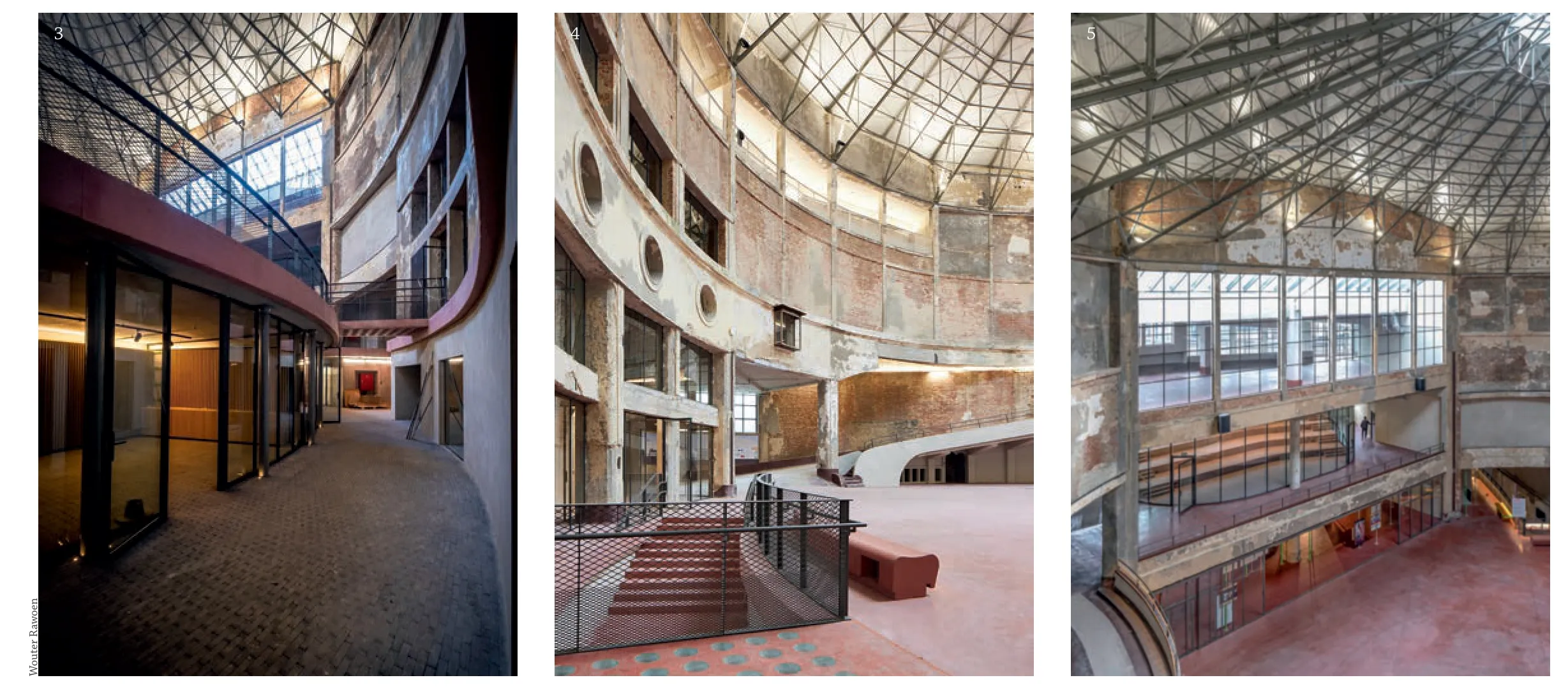
3-5 内景Interiors
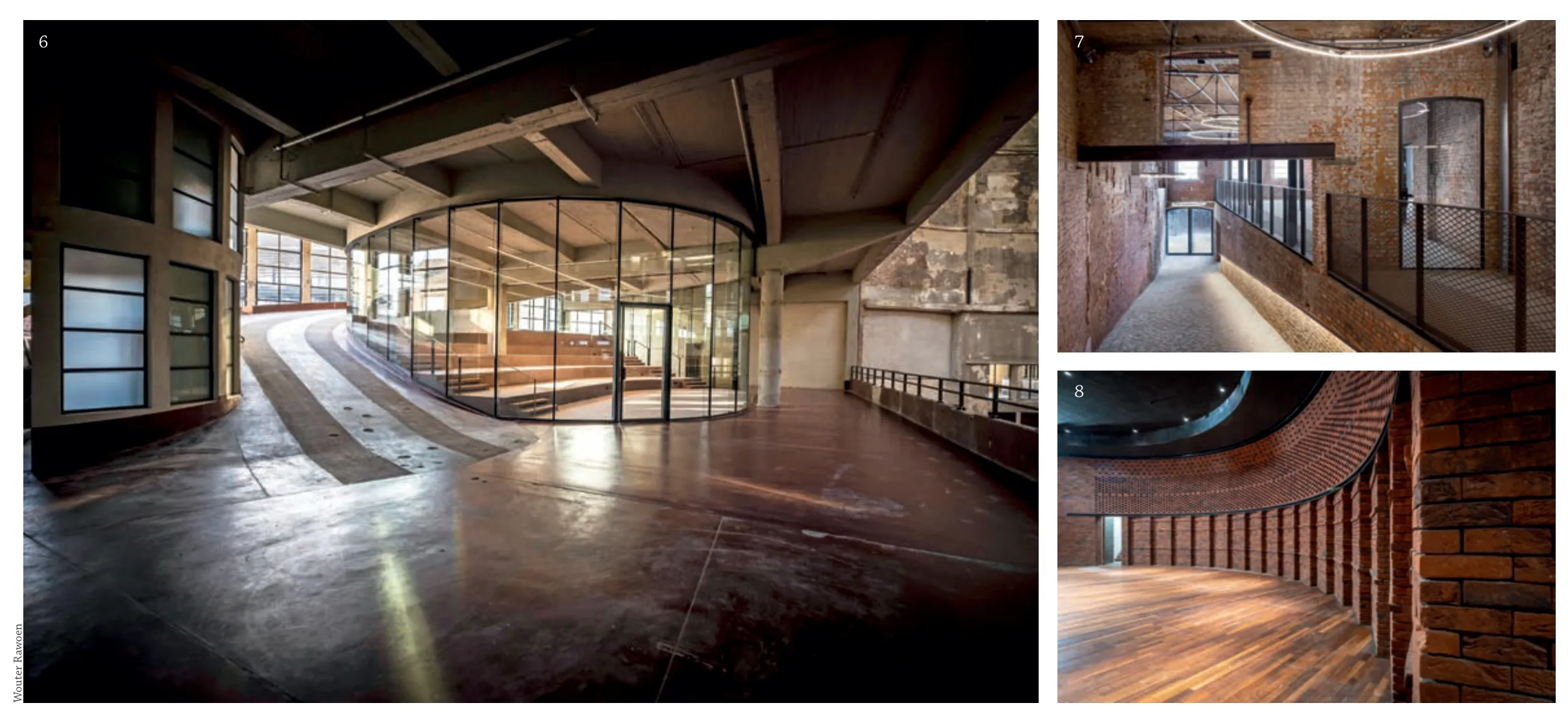
6.7 坡道Slopes
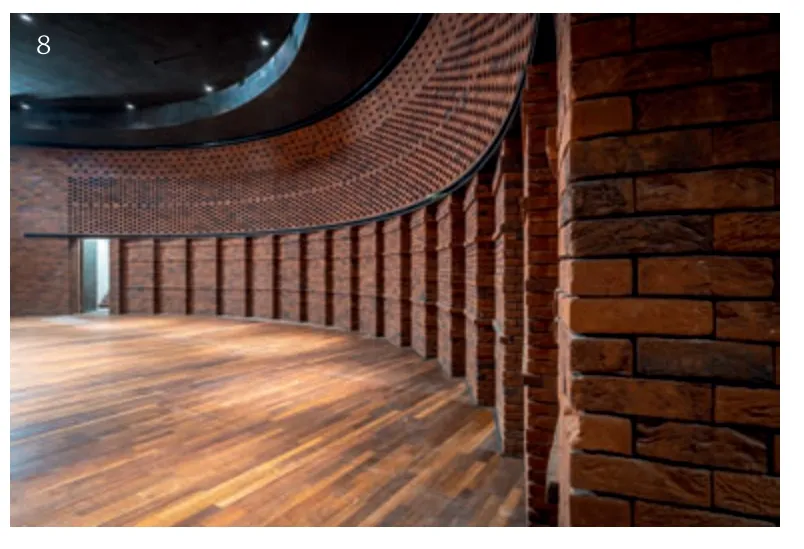
8 细部Details
第四,设计师表达了对该建筑在时间上所经历的许多复杂调整所产生的共鸣:在新的概念中整合和激活它们本身就成为一种设计目标。后来加建的部分,如混凝土坡道、旧的大象坡道也被包括在新项目中。此外,位于老车库污水井内的旧驾驶轨道将在未来的咖啡馆中重新利用。
建筑的未来
冬季马戏场的新建筑方案为游客考虑了全面的无障碍环境。人们都可以通过3 个入口进入内部广场——除了现有的两个入口(在Lammerstraat 街和Sint-Pietersnieuwstraat 街),还增加了Miriam Makebaplein 广场的一个新入口,从那里可以进入最近由建筑师RCR/Coussée Goris Huyghe architecten 在Plattenberg 新建的公共图书馆。
在未来的大楼里,各种活动,例如展览、公开演示或小型博览会,都可以进行。工位区将围绕中间的竞技场布置,初创企业、上升企业和技术公司可以灵活地(一起)为未来的社会挑战提供技术解决方案。社区活动的区域也已经建立起来,包括第三方在内的每个人都可以使用。在中间竞技场那一层,还提供了一个双层的零售功能区,符合根特市作为知识、文化和创新创业中心的更广泛愿景。
过去大象进入冬季马戏场的内部坡道现在变成了一个公共空地;以前的马厩变成了会议室。马戏场的表演区将被一个全新的可容纳120 人的礼堂取代;会议室、休息区、礼堂和露台酒吧为游客提供了城市的视野。二楼还有向中央竞技场开放的一个咖啡馆和一个餐厅的空间。
为了配合到2050 年成为碳中和城市的目标,该建筑在冬季马戏场的中央竞技场下安装了一个中和CO2的供暖系统。钻孔储能提供了一种新的技术,即利用土壤的温度来加热和冷却建筑物。得益于该领域,热量在冬季从土壤中被提取出来——对能源花费和气候来说都是一种胜利。
总而言之,这座建筑似乎给根特市民带来了活力并赢得了他们的喜爱,这不仅是因为它充满活力的表现和雄心勃勃的计划,最重要的是它所展示的一种完整性:通过有意避免强加另一种标志性,并小心翼翼地回避新旧对比,该建筑温和地透出一种谦逊的气质。这种慷慨预示着这座令人眼花缭乱的复合性建筑将有一个令人兴奋的未来:通过这种方式,冬季马戏场就可以庆祝新的前景,在空间性、物质性和氛围调性上保留其狂野的魅力,而不会被它所奴役。□
First,the central arena,a covered inner courtyard of 1200 m²,is deliberately left empty and will be accessible to everyone during the day.For the designers,the openness of the arena is a quality that needs to be safeguarded.
Secondly,the acoustic challenges of the underground rock concert hall demanded specific measures to prevent sound leakage to neighboring building.By the same token,the refurbishment of the existing dome also proved to be a challenge.The cover of the roof was renewed,including new restrictions concerning stability,insulation and acoustics.
Thirdly,akin to the Ruskin's second Lamp of Architecture on truth in architecture,the designers chose to retain its rough unplastered brick walls finishing as if it belongs to the soul of the building.Old plaster ceilings have been brushed off,but further deliberately left untouched,keeping the interior atmosphere intact.Original elements such as the iron cast columns and old stone drinking wells of the old horse stables have been retained.This truthful and intelligent display of what has been echoes the designer's respectful attitude.
Fourthly,the designers showed empathy for the many complex adaptations the building has undergone in time: it became a design endeavor in itself to integrate and activate them in the new concept.Later additions such as the concrete ramps,the old elephants ramp,have also been included in the new project.Furthermore,the old driving tracks located within the sewage wells of the former garage will be reused in the future café.
Architectural Future
The new architectural program of the Winter Circus envisages full accessibility for the visitor.The interior square will be accessible to everyone through three entrances;the two existing ones (in Lammerstraat and Sint-Pietersnieuwstraat) have been supplemented by a new entrance at the Miriam Makebaplein,giving access to the recent new public library by RCR/Coussée Goris Huyghe architecten on Plattenberg.
In the future building,all kinds of activities can take place,exhibitions,public demonstrations or small fairs. Workstations will be set up around the middle arena where start-ups,scale-ups and technology companies can work flexibly (together) on technological solutions for the social challenges of tomorrow.Community areas have also been set up,which everyone will be able to use,including third parties.At the level of the middle arena,a duplex has also been provided for a retail function that fits in with the broader vision of Ghent as a center for knowledge,culture and innovative entrepreneurship.
The interior ramp onto which elephants descended into the Winter Circus now becomes a public esplanade;The former horse stables turn into meeting rooms.The old scene of the circus will give rise to a completely new auditorium for 120 persons;Meeting rooms,lounge areas,an auditorium and a terrace bar provide the visitor with a view of the city.Opening towards the central arena,there is also space for a café and a restaurant on the second floor.
In tune with the aim of being a climate-neutral city by 2050,the building houses a CO2-neutral heating system under the central arena of the Winter Circus.The Boreholes Energy Storage (BEO)offers a new technique in which the temperature of the earth is used to heat and cool a building.Thanks to the field,the heat is extracted from the soil during the winter.A win for the energy bill and also for the climate.
All in all,this building seems to energize and win the hearts of many citizens in Ghent,not only for its energetic performance,ambitious program but foremost its display of integrity: by deliberately not imposing yet another kind of signature and carefully avoiding contrasts between new and old,the architecture gently breaths a sense of modesty.This generosity anticipates an exciting future for this dazzling and complex building: in so doing,the Winter Circus celebrates new horizons,retaining its wild charm in terms of spatiality,materiality and atmospheric quality,without becoming enslaved by it.
译注
Notes from Translater
i)指永久性的马戏场建筑。
